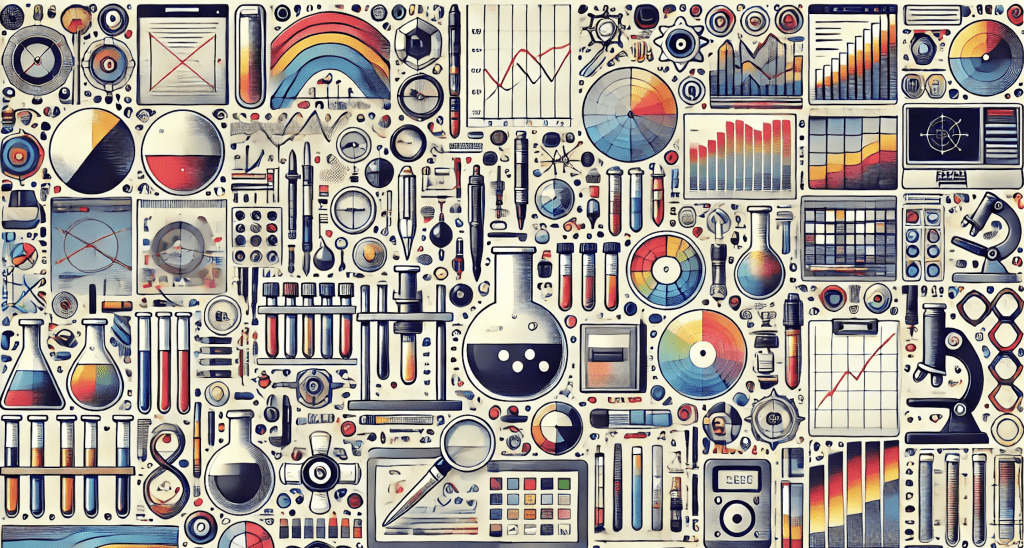In today’s competitive business landscape, a visually compelling and strategically sound graphic design can be the linchpin of a brand’s success. The traditional methods of graphic design, often rooted in subjective aesthetics, are evolving. More and more brands are integrating scientific approaches into their design processes to ensure that their visuals resonate with their target audiences, optimize user experiences, and align with business goals.
At Bl3nd Design, a graphic design company in Abbotsford British Columbia Canada, we recognize the importance of incorporating scientific rigor into creative processes. This method ensures that design choices are not only visually appealing but also data-driven and aligned with consumer psychology. In this article, we’ll explore how a scientific approach to graphic design strategy can transform the way businesses plan, execute, and refine their visual identities.
Introduction: The Intersection of Science and Design
Graphic design is no longer just about creating beautiful visuals; it is about creating purposeful and effective communication. The integration of a scientific methodology into graphic design strategy allows businesses to use data and psychological insights to craft designs that not only attract attention but also drive user engagement and conversions.
A scientific approach helps address fundamental questions: Who are we designing for? What problems are we solving? When is the best time to implement changes? Where will the design be most effective? Why should this design work? How do we measure success? By answering these questions systematically, businesses can create design strategies that are measurable, iterative, and continuously improving.
Who: Understanding the Audience
One of the first steps in a scientifically grounded design strategy is understanding the audience. This goes beyond demographic information; it involves understanding the psychology behind user behavior. Knowing what motivates your audience, their pain points, and their decision-making processes is crucial.
Businesses need to conduct user research, gather data on customer preferences, and observe how users interact with designs. This user-centric data informs the creation of designs that are not only visually appealing but also functional, intuitive, and aligned with the user’s goals. For instance, if a company’s target audience consists of time-constrained professionals, the design should prioritize clarity, simplicity, and ease of navigation.
What: Defining the Problem
Before any design work begins, businesses must clearly define the problem they are trying to solve. Is it a brand identity issue? Is the company struggling with low conversion rates on a landing page? Or is there a challenge in engaging users across multiple platforms? By defining the problem through a scientific lens, businesses can narrow their focus to design solutions that directly address these challenges.
In this stage, companies often analyze their existing data, such as conversion rates, user engagement metrics, or customer feedback. This analysis helps to pinpoint inefficiencies or areas where design could be improved, enabling businesses to craft strategies that have tangible, measurable outcomes.
When: Timing and Experimentation
The timing of design interventions is as important as the design itself. A scientific approach advocates for continual testing and iteration. For example, businesses can use A/B testing to assess which design elements are more effective in achieving specific goals, such as increasing website traffic or boosting social media engagement. By running controlled experiments over a specified period, companies can gather data on how their designs perform under different conditions.
Timing also applies to the design cycle itself. In a dynamic market, it’s essential to periodically review and update designs based on new data and insights. This iterative approach allows businesses to stay ahead of trends and maintain a fresh, relevant brand image.
Where: Context and Platform
The “where” of graphic design refers to the platform or medium where the design will be displayed. A design that works well on a website may not translate as effectively to a mobile app or social media post. Different platforms require different design considerations, and a scientific approach ensures that designs are optimized for their intended environments.
For instance, designs meant for social media should account for fast scrolling behavior, whereas a corporate website may allow for more detailed and immersive visuals. Using data from user interactions, businesses can determine where to invest their design resources for maximum impact.
Why: The Importance of User Psychology and Intent
Understanding the “why” behind design choices is rooted in the psychology of user behavior. This is where a scientific approach truly shines, as it integrates principles from cognitive psychology, behavioral economics, and neuromarketing to create designs that influence users on a subconscious level.
For example, color psychology plays a significant role in how users perceive a brand. Warm colors like red and orange can evoke excitement or urgency, while cooler tones like blue and green tend to be associated with trust and calm. Similarly, the placement of call-to-action buttons, the layout of information, and the use of white space all influence user behavior and decision-making.
By leveraging scientific insights into human psychology, businesses can create designs that not only look good but also guide users toward desired actions, such as making a purchase or signing up for a newsletter.
How: Implementing the Scientific Method
The “how” of implementing a scientific approach to graphic design strategy involves adopting a systematic, data-driven framework that allows businesses to create, test, and refine their designs continuously. This method parallels the scientific method used in empirical research, enabling designers to move beyond subjective decision-making and rely on measurable outcomes that can be iterated for continuous improvement.
Let’s break down the process into actionable steps:
Observation: Gathering Data and Identifying Pain Points
The first step in any scientific process is observation, and in the context of graphic design, this means collecting and analyzing relevant data. You begin by evaluating your current design assets, user interactions, and performance metrics to understand how your audience engages with your visual content. This stage is about uncovering insights—whether through analytics, user feedback, or industry benchmarks—that can guide design decisions.
Key activities in this phase include:
- Website Analytics: Tools like Google Analytics can provide information on bounce rates, time on site, click-through rates (CTRs), and user flows. If visitors are dropping off quickly or not engaging with calls to action (CTAs), it indicates that certain design elements may need improvement.
- Heat Maps and User Tracking: Heatmaps from services like Hotjar or Crazy Egg can show where users are clicking, scrolling, or ignoring on a webpage. These insights help determine whether certain areas of your design are being overlooked or are not intuitive enough.
- Surveys and Feedback: Direct feedback from users through surveys or usability tests is invaluable. Ask users about their experience interacting with your website, app, or marketing materials to understand pain points or friction areas.
- Industry Benchmarking: Compare your design performance metrics with industry standards or competitors. Are your engagement rates lagging? Are your conversion rates below average for your sector?
Once this data is gathered, you will begin to see patterns that point to strengths and weaknesses in your design.
Forming Hypotheses: Creating Data-Driven Assumptions
Based on the data collected during observation, the next step is to form hypotheses. A hypothesis in graphic design is a testable assumption that predicts the outcome of a design change. It’s important to ground these hypotheses in the data you’ve gathered. Instead of guessing or relying on intuition, you’re making educated predictions about what design elements will improve performance.
For example, if heatmap data shows users are not scrolling far enough to see the CTA on your webpage, a hypothesis might be:
- “If we move the CTA above the fold, then we will increase click-through rates by 20% because more users will see it without scrolling.”
Or, if a survey reveals users find your landing page overwhelming, you might hypothesize:
- “If we reduce the number of elements on the landing page and introduce more white space, user engagement will improve because the design will be less cluttered and easier to navigate.”
Forming clear, testable hypotheses is crucial because it defines the direction of your experimentation and allows you to focus on measurable outcomes.
Designing Experiments: Setting Up Controlled Tests
Once you have your hypotheses, the next step is to design experiments that allow you to test your assumptions. The key here is to change one variable at a time to ensure that any change in results can be attributed to that specific modification. This approach ensures that you get clear, actionable insights from each test, rather than muddying the waters by making multiple changes at once.
Common testing methods include:
- A/B Testing (Split Testing): In A/B testing, two versions of a design element are presented to users at random, and performance metrics are tracked for each. For example, if your hypothesis is that a new CTA color will increase clicks, you’d test the original color (A) against the new color (B) and measure which one leads to more conversions.
- Multivariate Testing: This method allows for testing multiple variables at once, which can be useful if you want to examine how combinations of different elements (e.g., headline, images, and button placement) impact user behavior. However, this approach requires larger sample sizes to achieve statistical significance.
- Usability Testing: Set up a small group of users to interact with the new design in a controlled environment. By observing their behavior and gathering qualitative feedback, you can determine whether the changes improve the user experience.
- Time-Limited Testing: In cases where you’re unsure about a broader design overhaul, you can run time-bound tests to assess the impact of temporary design changes (e.g., altering homepage banners during a promotional event). Short, controlled tests allow you to gather insights without making permanent changes.
Data Collection: Monitoring and Measuring Results
Once the experiment is running, data collection begins. It is essential to monitor key performance indicators (KPIs) that are directly linked to your hypothesis. The types of metrics you track will vary depending on the nature of the design being tested. Common KPIs for graphic design experiments might include:
- Click-through Rates (CTR): For elements like buttons, banners, or CTAs, tracking how many users click through to the next step can indicate the effectiveness of your design changes.
- Conversion Rates: This metric shows how many users complete a desired action, such as signing up for a newsletter, making a purchase, or filling out a form. Improved conversion rates are a clear sign that your design is working.
- Bounce Rate: If your hypothesis involves improving user engagement, then tracking bounce rates (the percentage of visitors who leave your site after viewing only one page) is crucial. A lower bounce rate suggests that users are finding your design more engaging and are exploring further.
- Session Duration: How long users spend on your site or app can provide insights into how engaging your design is. If users are spending more time, it’s likely your design is facilitating a better experience.
- Heatmap and Scroll Data: During the testing phase, continue using heatmaps and scroll tracking to see whether changes are encouraging users to engage with previously ignored elements or scroll further down the page.
Analyzing the Data: Drawing Conclusions
Once you’ve gathered enough data from your experiments, the next step is to analyze the results. This is where the scientific approach truly adds value, as it allows you to objectively assess whether the design changes had the desired effect and why.
Here’s how to approach this stage:
- Did the Experiment Meet Your Expectations?: Compare the actual outcomes to your hypothesis. If your hypothesis was, “Moving the CTA above the fold will increase clicks by 20%,” did the test produce that result? If so, your hypothesis was validated. If not, explore why the result differed.
- What Insights Can You Draw?: Whether or not your hypothesis was correct, analyzing the results will offer valuable insights. For example, if changing the CTA color had no impact, but a change in copy increased clicks, it might reveal that the language of your CTA is more critical than its design. This information will guide future design decisions.
- Segment the Data: It’s important to dive deep into the data. Look at how different segments of your audience responded to the design changes. Did mobile users behave differently from desktop users? Did one demographic respond more positively than others? Segmenting the data helps you understand the nuances of user behavior and refine your designs accordingly.
Iterating and Refining the Design: Continuous Improvement
After analyzing the data, the next step is to refine the design based on what you’ve learned. Even if the test was successful, there is always room for improvement. The iterative nature of a scientific approach means you can continuously tweak, test, and optimize your design for better performance.
For example, if moving the CTA increased clicks but didn’t improve conversions, you may need to adjust other design elements, such as the form layout or value proposition, and test again. Each iteration should build on the previous one, incorporating new insights to drive better outcomes.
Iteration also involves looking at long-term patterns and trends. A design tweak that works well in the short term may lose effectiveness over time as user behavior or market conditions change. By continuously testing and refining, you can ensure that your designs remain relevant and effective in the long run.
Scaling and Automating: Leveraging Technology
As you refine your processes and identify winning design strategies, the next step is to scale your efforts. Many businesses use automation tools to conduct continuous testing and optimization without requiring manual intervention. For example:
- Marketing Automation Tools: Platforms like HubSpot or MailChimp allow businesses to A/B test email designs automatically and send the most effective version to the broader audience based on real-time results.
- Personalization Engines: Tools such as Optimizely or Dynamic Yield allow businesses to create personalized design experiences for different segments of their audience. These platforms use machine learning algorithms to continuously test and optimize design elements for specific user groups.
By leveraging these tools, you can take the scientific approach to graphic design to the next level, making real-time adjustments based on data without manual oversight. Automation ensures that design improvements are scalable and sustainable as your business grows.
Reporting and Communicating Results
Finally, it’s essential to communicate the results of your experiments to stakeholders, whether they are internal teams or clients. A scientific approach to design provides the added benefit of producing concrete, data-driven insights that can be shared in reports or presentations. This transparency helps build trust and ensures that future design decisions are aligned with business objectives.
In your reports, focus on:
- Outlining Hypotheses and Results: Clearly articulate what you tested, why you tested it, and what the outcome was.
- Quantifying Success: Use metrics like conversion rate improvements, increased time on site, or reduced bounce rates to showcase the success of your design experiments.
- Providing Actionable Recommendations: Based on the results, offer clear, actionable recommendations for further design improvements or strategy shifts.
Outcomes: Data-Driven Success
The ultimate goal of using a scientific approach to design is to create outcomes that are not only aesthetically pleasing but also measurable and effective. By regularly testing and iterating on designs, businesses can ensure that their visual strategies lead to tangible improvements, whether that’s increased user engagement, higher conversion rates, or enhanced brand loyalty.
Analyzing and Iterating for Continuous Improvement
The key to long-term success in graphic design is continuous iteration. After implementing and analyzing a design strategy, businesses should regularly revisit their assumptions and data. What worked six months ago might not work today, as user preferences, technologies, and market conditions change.
This ongoing cycle of testing, analyzing, and refining ensures that the design evolves in line with the business’s goals and the needs of its audience. Businesses that adopt a data-driven, scientific mindset are better equipped to pivot quickly and adapt to changes, giving them a competitive edge.
Why More Brands Are Including Science in Their Marketing
Incorporating a scientific approach into marketing and design is becoming increasingly common because it brings objectivity and precision to creative processes. More companies, particularly in health, wellness, and beauty, are conducting scientific studies to validate their product claims and using these findings to build consumer trust. Brands like Ritual and Elix, for example, have successfully used clinical trials and data-backed studies to boost their credibility and drive sales .
Similarly, in the realm of graphic design, data-driven strategies help companies create visuals that resonate more deeply with consumers, leading to stronger brand loyalty and increased conversions. By blending creativity with science, businesses can ensure their designs are not only beautiful but also effective and impactful.
The Future of Design is Scientific
At Bl3nd Design, we believe the future of graphic design lies at the intersection of creativity and science. By adopting a scientific approach, businesses can create designs that are not only visually striking but also strategically aligned with user behavior and business objectives. This method allows for continual improvement, data-driven decision-making, and, ultimately, designs that deliver measurable success.
Whether you’re looking to redesign your brand identity, optimize your website for conversions, or create more engaging social media graphics, using a scientific approach to graphic design strategy will ensure your visuals are effective, impactful, and built to adapt to an ever-changing market.
Resource Links
Stanford University
National Library of Medicine
Government of Canada
Science Direct
Live Science
American Journal Experts
WebMD Blog
University of Waterloo
University of Berkeley
University of Nevada
Science Buddies
Wikipedia





















